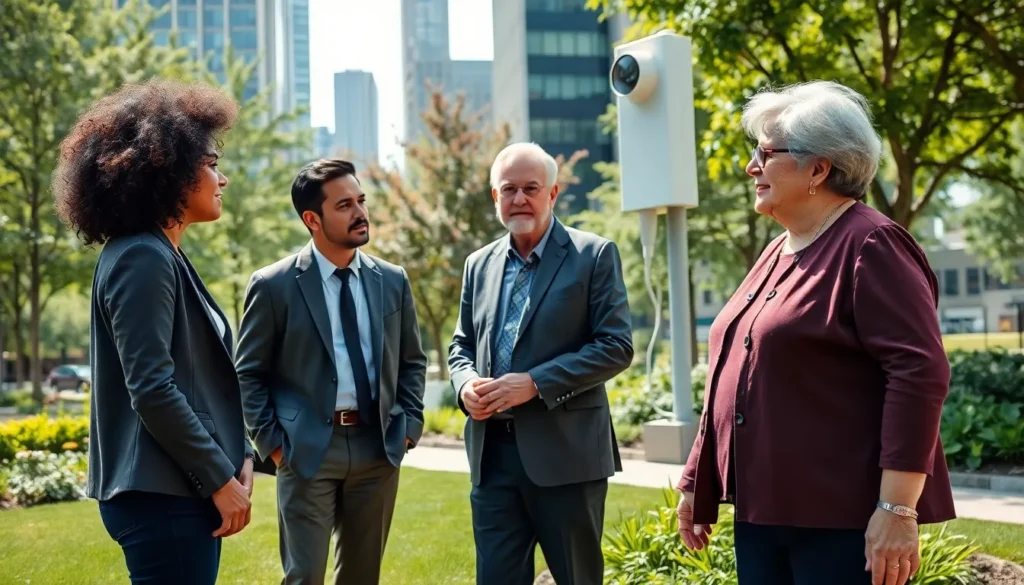Table of Contents
ToggleIn a world increasingly plagued by air pollution, innovative technology is stepping up to tackle this pressing issue. From smart sensors that monitor air quality to advanced filtration systems, tech for clean air is transforming how communities breathe. These solutions not only enhance public health but also promote a sustainable future.
As urban areas expand and industrial activities rise, the need for cleaner air has never been more urgent. The intersection of technology and environmental stewardship offers hope, empowering individuals and organizations to take action. With the right tools, it’s possible to create healthier living spaces and contribute to a cleaner planet.
Overview of Tech for Clean Air
Technological advancements play a crucial role in combating air pollution. Numerous innovations focus on improving air quality through smart solutions and efficient systems.
Air Quality Monitoring Systems
Air quality monitoring systems utilize smart sensors to track pollutants in real time. These systems provide data on particulate matter, volatile organic compounds, and various gases. By delivering accurate information, they empower individuals and organizations to make informed decisions regarding air quality management.
Advanced Filtration Technologies
Advanced filtration technologies include HEPA filters and Activated Carbon filters. HEPA filters capture 99.97% of particulate pollutants, making them essential for indoor air purification. Activated Carbon filters absorb harmful gases and odors, enhancing overall air quality in residential and commercial spaces.
Air Purification Devices
Air purification devices help reduce airborne contaminants. Standalone units and integrated HVAC solutions effectively eliminate allergens, bacteria, and viruses. These devices contribute to healthier indoor environments, improving well-being and productivity.
Green Infrastructure Innovations
Green infrastructure innovations include vertical gardens and green roofs. These technologies use natural processes to filter and purify air while providing aesthetic benefits. They contribute to lowering urban heat and improving biodiversity, thus enhancing urban environments.
Renewable Energy Solutions
Renewable energy solutions reduce reliance on fossil fuels, consequently lowering air pollution. Solar panels and wind turbines generate clean energy, creating cleaner urban air. Adoption of these technologies contributes to a sustainable future and promotes public health.
Legislative and Policy Support
Legislative and policy support encourages the development and implementation of clean air technologies. Regulations, incentives, and funding opportunities drive innovation and adoption of air quality improvements. Government initiatives foster collaboration between the public and private sectors, supporting progress in air quality technology.
Innovative Technologies

Innovative technologies play a crucial role in improving air quality. They encompass a range of systems and solutions designed to combat air pollution effectively.
Air Quality Monitoring Systems
Air quality monitoring systems utilize smart sensors to measure pollutants and provide real-time data on air quality. These systems detect harmful substances, including particulate matter (PM2.5 and PM10), volatile organic compounds (VOCs), and nitrogen dioxide (NO2). Many devices incorporate IoT technology, allowing users to access data through mobile applications. For instance, the Air Quality Index (AQI) uses standardized measurements to report on pollution levels, helping communities make informed decisions about outdoor activities. These systems enable governments and organizations to allocate resources efficiently, enhancing public health and safety.
Air Purification Solutions
Air purification solutions include advanced filtration systems designed to reduce indoor air pollutants. HEPA filters capture at least 99.97% of particles 0.3 microns in size, effectively removing dust, allergens, and other contaminants. Activated Carbon filters further absorb gases and odors, improving indoor air quality. Portable air purifiers provide flexibility for individual rooms or specific areas, while integrated systems filter air throughout buildings. Additionally, innovative approaches like photocatalytic oxidation use light to activate catalysts that eliminate bacteria and volatile organic compounds. Implementing these air purification solutions enhances comfort and health in living and working spaces.
The Role of Renewable Energy
Renewable energy sources significantly influence air quality by reducing dependence on fossil fuels and lowering greenhouse gas emissions. Solar and wind energy technologies contribute to innovative solutions that enhance air cleaning efforts.
Solar-Powered Air Cleaning Devices
Solar-powered air cleaning devices harness sunlight to operate filtration and purification systems. These devices typically feature solar panels that generate electricity, driving fans and filtration processes without relying on grid power. Solar air purifiers utilize technologies such as HEPA and UV-C light, effectively trapping particulate matter while neutralizing pathogens. Case studies, such as those implemented in urban areas, demonstrate a direct correlation between solar-powered devices and improved air quality metrics, thereby promoting sustainability.
Wind Energy in Air Quality Improvement
Wind energy plays a vital role in decreasing air pollution levels. Wind turbines generate clean electricity, which minimizes reliance on coal and natural gas facilities. The introduction of large-scale wind farms leads to a significant reduction in air pollutants such as sulfur dioxide (SO2) and nitrogen oxides (NOx). Furthermore, integrating wind energy into smart grid systems enables real-time management of energy consumption, aligning power generation with reduced emissions. Research indicates that regions utilizing wind energy show lower instances of respiratory diseases linked to poor air quality, benefiting public health.
Policy and Regulation Impact
Policy and regulation significantly influence the development and adoption of clean air technologies. Supportive government initiatives and established industry standards create an environment conducive to innovation and implementation.
Government Initiatives
Government initiatives play a crucial role in promoting clean air solutions. Programs funded by federal and state governments aim to reduce air pollution through technological investments. For instance, the U.S. Environmental Protection Agency (EPA) implements grants to support the development of air quality monitoring systems and pollution control technologies. Additionally, regulations like the Clean Air Act establish standards for air quality, pushing industries to adopt cleaner technologies. Cities that implement local ordinances, such as incentives for using renewable energy, tend to see faster advancements in air-cleaning innovations.
Industry Standards
Industry standards set guidelines that ensure the effectiveness and safety of clean air technologies. Organizations such as the American National Standards Institute (ANSI) provide benchmarks for air quality monitoring systems and filtration technologies. Compliance with these standards assures consumers and businesses of product reliability. Regulatory bodies frequently update these standards to accommodate technological advancements, promoting ongoing innovation. Industries that adhere to strict emissions standards, like those defined by the EPA, are more likely to invest in and deploy advanced air purification technologies, contributing to improved public health and environmental outcomes.
Future Trends in Air Quality Technology
Emerging trends in air quality technology highlight significant advancements poised to improve air purity and public health. Manufacturers are focusing on integrating artificial intelligence (AI) and machine learning (ML) into air quality monitoring systems, enhancing data analysis capabilities. AI algorithms can predict pollution spikes and assess the effectiveness of mitigation measures in urban settings, offering proactive solutions for improving air quality.
Innovative sensor technology is evolving, with advancements in materials and miniaturization enabling more effective monitoring of various air pollutants. Low-cost, portable air sensors will allow individuals and communities to access real-time air quality data. This trend empowers citizens to take control of their environmental health and fosters community engagement in air quality management.
Smart cities are at the forefront of air quality technology development, leveraging connectivity and data analytics to optimize pollution control efforts. Urban planners are incorporating air quality data into city design, enhancing traffic flow and green space distribution to minimize emissions. This trend promotes sustainability while improving overall living conditions in urban environments.
The integration of nanotechnology in air purification systems is gaining traction, with researchers investigating nanomaterials that can capture particulate matter more efficiently. Nanofilters can remove ultra-fine particles and gases, improving indoor air quality significantly. This approach offers potent solutions for mitigating pollution in densely populated areas.
Biotechnological innovations represent another frontier, with developments in biofilters using living organisms to remove pollutants. These filters deploy microorganisms that metabolize harmful substances, demonstrating an environmentally friendly approach to air purification. Businesses and municipalities can implement biotechnological solutions to reduce their carbon footprints and promote healthier ecosystems.
Collaboration between tech companies and governments fosters innovation in clean air technologies. Public-private partnerships aim to accelerate research and development of emerging solutions. By sharing resources and information, stakeholders can develop comprehensive strategies for air quality improvement, addressing both local and global air pollution challenges.
The collection and use of big data analytics are poised to revolutionize air quality management. Extensive data sets from diverse sources enable better trend analysis and informed decision-making. Governments and organizations can identify pollution hotspots and assess the impact of policy changes, driving effective environmental strategies.
These emerging trends underscore the proactive role of technology in shaping cleaner, healthier air for future generations. By integrating advanced technologies and fostering collaborative efforts, stakeholders are addressing air pollution on multiple fronts, enhancing public health and promoting sustainable living environments.
Technology is paving the way for cleaner air and healthier living environments. With innovative solutions like smart sensors and advanced filtration systems, individuals and communities can actively combat air pollution. The integration of renewable energy sources further enhances air quality while promoting sustainability.
As advancements continue to emerge, the collaboration between tech companies and governments will play a crucial role in driving progress. By embracing these technologies and supporting policies aimed at improving air quality, society can work towards a future where clean air is not just a luxury but a standard. The journey towards better air quality is ongoing and requires collective effort, but the potential for positive change is immense.







